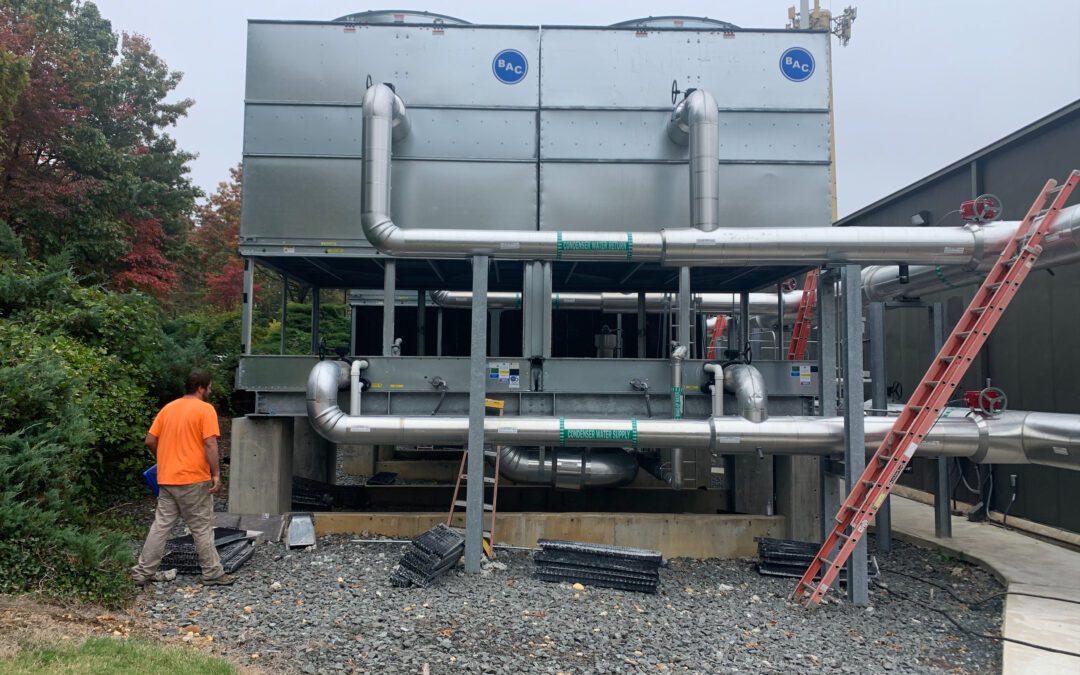-How do you gain the maximum life from a Cooling Tower?
-How a Cooling Towers function? Cooling Tower 101 anyone?
-What types of Cooling Towers are commonly used in industrial applications?
-What are the primary causes of corrosion?
-What type of product is best for Cooling Tower Rehabilitation?
In the simplest of terms, A cooling tower is a specialized heat exchanger, found in many industries such as power plants, chemical processing, oil refining, steel mills, waste incineration and many of manufacturing companies, even Hospitals where process cooling is necessary.
Cooling towers utilize the natural process of evaporation to exchange the waste heat produced from industrial processing equipment for cooler water, which then gets reused over again. This is done by forcing air (often via a cooling fan) and water to come into contact with one another.
A Cooling Tower follows these steps to exchange heat in water:
The warm water from the industrial processes, often air conditioning condensers, gets pumped into the cooling tower through pipes.
Then, the water is then sprayed onto a heat exchange surface (fill) to maximize air-water contact. The water is then exposed to air that is being pulled through the tower by an electric motor-driven fan.
When the water and air meet, water begins to evaporate, creating a cooling action.
Then, the remaining cooled water collects in the tower basin and gets pumped back into the process equipment, repeating the loop, using as much of the water as possible.
Types and Sizes of Cooling Tower
Cooling towers vary in size and design and are classified by the type of draft (natural or mechanical), Water cooled or air-cooled and by the direction of air (counterflow or crossflow). The Cooling Technology Institue posted a great “Benefits of Water cooled verus air cooled that you can check out here! However, all have the same primary function – to exchange heat – in the most efficient way possible.
Now…HERE COMES TROUBLE WITH A CAPITAL “C”
It’s called…
Corrosion
What causes corrosion in cooling towers?
Over time, we all know water will corrode just about anything. This, in combination with harsh industrial chemicals, is exactly why corrosion is a very real concern for cooling towers.
Corrosion is caused by the reaction of air, sodium, and other chemical components found in the water supply. This chemical reaction causes the destruction or loss of the metal within the cooling tower.
Prevent Corrosion
Without preventative measures, it can impact the safety and efficiency of the entire cooling process, in turn, increasing energy costs. If corrosion manages to progress even further it could cause damage or destruction to the equipment within the tower and lead to dangerous failures and costly repairs.
The key to preventing or at least limiting corrosion in your cooling tower?
Polymeric Coatings
One thing we believe strongly in at Southern Industrial Linings is Polymeric applications. We have nearly 3 decades of experience in “Poly.” Polyurea lining systems have redefined the whole concept of cooling tower coatings. Polyurea is one of the most rugged industrial lining systems used today. Polyurea has about 2,000 psi tensile strength and it gels exceptionally fast so it can easily bridge holes.
Polyurea is a super efficient and strong coating. It’s a rubber-like polymer that can be sprayed onto any appropriate surface. Polyurea has a trusted history too, as companies looked for ways to save on industrial repair costs, manufacturers developed it in the late ’90s as a money-saving alternative. Soon, many Commercial Mechanical companies started using it more frequently as repair became preferable to replacement.
Save money while protecting the life span of your Cooling Towers. Got a job to tackle? Reach out to us and let’s talk about your Cooling Tower project.


